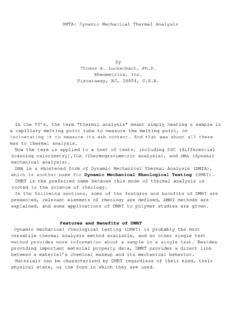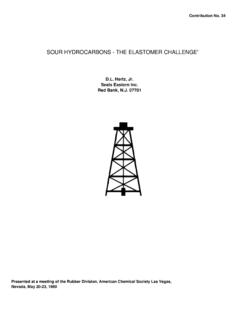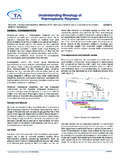Transcription of Variational principles in the linear theory of viscoelusticity
1 Variational principles in the linear theory of Viscoelasticity M. E. GURTIlV Communicated by E. STERNBERG 1. Introduction The object of this paper is to supply generalizations to linear quasi-static viscoelasticity theory of certain Variational principles which characterize the solution of the mixed boundary-value problem of classical elastostatics. This problem consists in finding a "state" -- a displacement, strain, and stress field -- which satisfies the governing field equations in a given region of space and meets the standard mixed boundary conditions.
2 The relevant field equations consist of the displacement-strain relations, the stress-strain relations, and the stless equations of equilibrium; whereas the boundary conditions involve the prescription of displacements over a portion of the boundary and of surface tractions o~ver the remainder. Two of the most important Variational principles applicable to the foregoing problem are the principle of stationary potential energy and the principle of stationary comPlementary energyL The former asserts that the variation of the "potential energy" over the set of all kinematically admissible states ~ is zero at a certain state i/and only i[ that state is a solution of the mixed problem under consideration.]
3 On the other hand the principle of stationary complementary energy asserts that the variation of the "complementary energy" over the set of all statically admissible stress fields 8 is zero at a certain stress field il that stress field belongs to the solution of the mixed problem. SOUTHWELL [21 and LANGHAAR [~ proved a converse of this theorem on the assumption that the tractions are prescribed over the entire boundary and the region is simply connected: the variation of the "complementary energy" over the set of all statically admissible stress fields 1 See, for example, SOKOLNIKOFF [1] (Articles t07, 108).]]
4 If the elastic constants are such that the strain energy density is a positive definite function of the strains, then these Variational principles imply corresponding minimum principles : 2 By a kinematically admissible state we mean a state that satisfies the dis- placement-strain relations, the stress-strain relations, and the displacement boundary conditions. 3 By a statically admissible stress field we mean a stress field that meets the stress equations of equilibrium as well as the traction boundary conditions.
5 T80 GVRTIN: is zero at a stress field only i! that stress field belongs to the solution of the problem at hand. For the case in which displacements are prescribed over a portion of the boundary a similar converse follows from an elementary generaliza- tion 4 of a theorem due to DORN & SCHILD [41. Various extensions of the preceding Variational principles of elastostatics have been established in which the class of admissible states is subjected to weaker restrictions. One extension of this kind was given by HELLINGER [51 and was later independently discovered in a somewhat stronger form by REISSNER [G 1, E71.]]]
6 This principle asserts that the variation of a certain functional over the set of all states which meet the strain-displacement relations is zero at a particular state if and only if that state is a solution of the mixed problem. Apparently guided by REISSNER'S improved version of HELLINGER'S theorem, Hu HAI-CHANG [8] and WASHIZU [91 separately arrived at a still broader Variational principle which does not require the admissible states to meet any of the field equations or boundary conditions. This paper aims at Variational principles for linear viscoelasticity which generalize the foregoing results of classical elastostatics.]
7 Although Variational principles for viscoelasticity theory were considered previously by BIOT I10], FREUDENTHAL GEIRINGER [11], and ONAT [121, these investigations do not arrive at generalizations of the type sought here. The present paper is a continuation of a recent study [18] which contains a systematic treatment of linear viscoelasticity theory based on the notion of a Stieltjes convolution. Section 2 contains certain preliminary definitions and notational agreements. In Section 3 Variational principles appropriate to the linear quasi-static theory of viscoelastic solids are given for the case in which the stress-strain relations are in relaxation integral form.
8 Section 4 is devoted to the derivation of analogous results for stress-strain relations in creep integral form. In the Variational prin- ciples established here the viscoelastic solid is allowed to be inhomogeneous and anisotropic and the relevant stress, strain, and displacement histories are per- mitted to possess finite jump discontinuities in time. 2. Notation. Preliminary definitions Throughout what follows R will denote an open region of three-dimensional Euclidean space with the closure/~ and the boundary B.
9 Further, n will denote the unit outward normal to B, and B~ (~ ---- 1,2) will denote complementary sub- sets 5 of B (B----B 1 ~B~, BI~Bi--O ). Finally, the symbol " will be used to indicate the Cartesian product of two sets. Let ui, eii, aii, Fi, Giikt, and Jiikz, in this. order, designate the Cartesian components of the displacement vector u, the strain tensor E, the stress tensor ~, the body force (density) vector F, the relaxation tensor G, and the creep tensor d. All of the preceding field histories, including G and d, are to be regarded as functions of position and time defined on R x (-- o% oQ).
10 With this notation the 4 See Section 4 for a statement and proof of the generalized theorem. 5 Henceforth the subscript c, will be understood to have the range of the integers (t, 2). Linearized Viscoelasticity t 8t complete system of field equations in the linear quasi-static theory of (inhomo- geneous and anisotropic) viscoelastic solids take the form e and either or 2eii=ui, i+ui, i on RX (-- 0% oo), ( ) aii, i+Fi=O, aii=aji on R (--oo, oo), ( ) aii= on R (-- oo, oo), ( ) eii=f,~kz*dakl on R (--0% o~).





